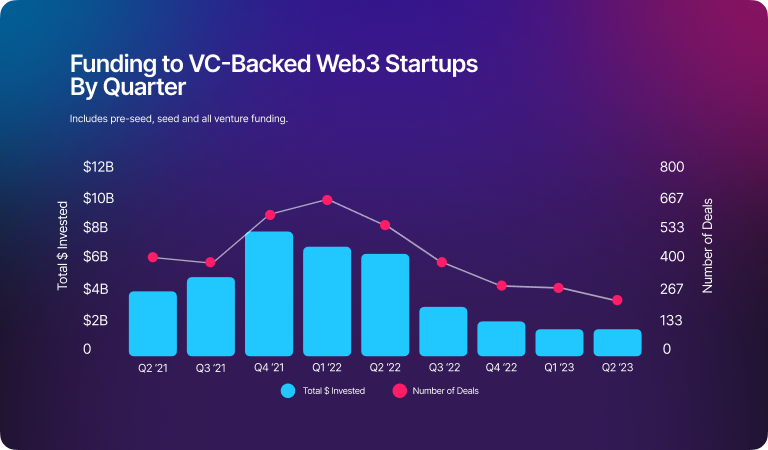Web3 is the next generation of the World Wide Web, commonly focusing on blockchain technology. The mainstream promise of Web3 intends to be more decentralized, secure, and transparent than the current web. This is the stance many believers take; however, we must also consider the same stance from statistical analysis and mass adoption of the tech. No one can deny that blockchain technology has embedded itself within society; however, we must also view the progress as fairly shallow and limited in necessity.

Web3 Gaming Use Cases
For gaming, the decentralized dream of Web3 has the potential to revolutionize the way we play games. Here are some of the ways that we could change gaming:
- Ownership of in-game assets: In traditional gaming, in-game assets are owned by the game developer. This means that players can't sell or trade their assets, and they're at the mercy of the developer if they want to access them. With decentralization, in-game assets can be tokenized and owned by players. This gives players more control over their assets, and it allows them to trade and sell them on decentralized marketplaces.
- Transparency: Web3 is said to be built on blockchain technology, which is a transparent and immutable ledger. This means that all transactions on the blockchain are publicly visible. This could lead to more transparency in gaming, as players would be able to see how their data is being used and who is profiting from it.
- Decentralization: Web3 dreams to be a decentralized platform, which means that it is not controlled by any single entity. This could lead to more freedom and innovation in gaming, as developers would be free to create games without having to comply with the rules of a centralized platform.
By enabling true ownership of in-game assets, players gain unprecedented control over their virtual possessions, allowing for seamless trading and selling on decentralized marketplaces. The transparency inherent in blockchain technology could bring about a new era of trust and accountability, as players will have visibility into how their data is being utilized and who benefits from it.
Meet the Industry Leaders
Here are some specific examples of how blockchains are already being used in gaming:
Axie Infinity: Axie Infinity is a blockchain-based game where players can collect, breed, and battle digital pets called Axies. Axies are NFTs, which means that they are owned by the players who purchase them. This gives players the ability to sell or trade their Axies on decentralized marketplaces.

The Sandbox: The Sandbox is a blockchain-based game where players can create, build, and monetize their own experiences. The game uses a voxel-based engine, which allows players to create highly detailed worlds. The Sandbox also has its own cryptocurrency, SAND, which can be used to buy and sell assets in the game.

Gods Unchained: Gods Unchained is a blockchain-based trading card game where players can collect, trade, and battle cards. The cards in Gods Unchained are NFTs, which means that they are owned by the players who purchase them. This gives players the ability to sell or trade their cards on decentralized marketplaces.

While blockchains are just one part of the mainstream view of what Web3 is to be, they are here today in use in several large titles. As the technology continues to develop, we can expect to see even more innovative and exciting uses of blockchain, and we can't wait to see what the full vision of Web3 turns out to be.
What are the challenges of Web3?
There are a number of challenges that need to be addressed before Web3 gaming can reach its full potential. These challenges include:
- Definition: While there is a public view of what Web3 is or will be, often involving blockchain, tokens and decentralization - there is far from a consensus on the topic.
- Scalability: Blockchains are a powerful technology, but it can be slow and expensive to use. This could be a challenge for Web3 gaming, as games require a lot of data to be processed and with instant results.
- Security: Blockchains are designed to be secure, but are not immune to vulnerabilities. This could be a challenge for Web3 gaming, as players would need to trust that their assets are safe.
- Adoption: Web3 is not one piece of technology, and blockchains are still a new technology that have yet to be widely adopted. This could be a challenge for Web3 gaming, as developers would need to find ways to attract players to their games.
Beyond this basic description of challenges the entire investment end of Web3 has seemed to plummet in this past year. Given the new technology it is important to all firms that they secure VC funding in order to finance their teams. As shown in the graph below one can see the trends affecting all Web3 startups across the sector:

Source: Crunchbase News
The promise of Web3 gaming, despite its challenges, presents an exciting realm of opportunities for the future. With the rise of blockchain technology and decentralized applications, Web3 gaming has emerged as a dynamic and innovative space that revolutionizes traditional gaming experiences. Although it faces some obstacles, such as scalability, user adoption, and regulatory hurdles, the potential for growth and transformation within the industry is immense.
